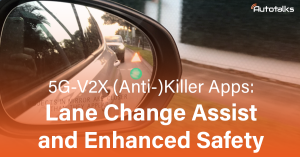By Sagit Adler
Living in a community where people care for each other’s safety and welfare is invaluable. While technology advances, we strive to retain the warmth and connectivity of a close-knit community while embracing the benefits that progress brings. One of the most significant technological advances in recent years is Vehicle-to-Everything (V2X) technology. It enables vehicles to interact with each other and the road environment. By facilitating the exchange of information between vehicles, infrastructure, and road users, V2X improves road safety and traffic efficiency. V2X technology can greatly enhance safety for Vulnerable Road Users (VRUs), especially children, the elderly and cyclists. While the benefits of V2X are tremendous, installing V2X-equipped infrastructure is surprisingly simple and can be especially effective in key locations like schools, shopping centers, and dangerous intersections.
Enhancing Safety for Vulnerable Road Users
VRUs are often at higher risk in traffic environments. Recently, e-bikes and scooters began getting equipped with V2X in order to be a part of the safety network created by V2X technology. V2X-equipped vehicles can receive alerts about bikes and scooters and take proactive measures, like braking or steering away to avoid collisions.
V2X Infrastructure
V2X equipped infrastructure is very helpful in preventing accidents. Smart infrastructure equipped with both cameras and V2X can be even more effective, particularly in protecting pedestrians, which are not yet equipped with V2X technology. For example, with the use of a smart traffic light, a vehicle can get an alert, communicated via V2X technology, of a pedestrian bursting unsafely into the road as detected by the camera. Additionally, V2X enables emergency vehicles to navigate intersections more safely and efficiently.
Implementing V2X infrastructure
Implementing V2X technology in local communities is more straightforward than one might expect. By focusing on key locations such as schools, shopping centers, and dangerous intersections, communities can maximize the benefits of V2X with minimal disruption:
- Schools: Installing V2X-equipped infrastructure near schools can significantly enhance the safety of children. Smart crosswalks can communicate with approaching vehicles to ensure they stop when children are crossing. Additionally, school buses equipped with V2X can alert nearby vehicles when children are boarding or alighting.
- Shopping Centers: Busy shopping centers often have high pedestrian traffic, making them ideal locations for V2X deployment. V2X-enabled traffic lights and crosswalks can ensure that pedestrians have safe passage, while vehicles can be alerted to the presence of pedestrians in parking lots and surrounding areas.
- Dangerous Intersections: High-risk intersections are prime candidates for V2X infrastructure. Smart traffic signals, combined with V2X-equipped vehicles, can drastically reduce the likelihood of collisions. These systems can monitor traffic patterns and adjust signal timings to enhance safety and efficiency.
V2X Deployment in the Community
While the USDOT (U.S. Department of Transportation) has begun executing its plan to equip city infrastructure with V2X technology, allocating substantial funds for the project, it is important for local residents to make their voices heard to ensure their community is part of the V2X infrastructure upgrade. Residents who want safer neighborhood roads should start taking action. Some simple steps include contacting local leaders and policymakers, creating a petition for V2X infrastructure to send to the USDOT and congressional representatives, and volunteering for pilot projects. Additionally, promoting V2X awareness on social media can help garner community support. This is the time to take action for safer roads.








